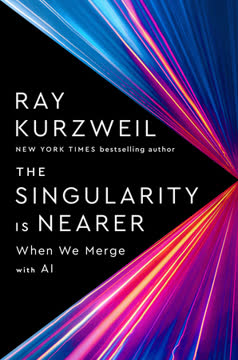重点摘要
1. 指数时代:快速的技术加速改变社会
当今社会的快速转型正是这样一个阶段性转变。我们已经达到了一个拐点,眼睁睁地目睹着我们的系统在转变。水正在变成蒸汽。
前所未有的变化。 我们正经历一个戏剧性的转型时期,这一切都源于指数技术的快速发展。这种变化不是线性的,而是以前所未有的速度加速,影响着我们生活的方方面面,从商业和政治到文化和个人关系。
历史背景。 与以往需要数十年才能展开的技术革命不同,指数时代的特点是突然的、颠覆性的变化在几年甚至几个月内发生。这种快速的变化挑战着我们的适应能力,同时也创造了新的机遇和风险。
- 指数变化的关键驱动因素:
- 计算机领域的摩尔定律
- 数字平台的网络效应
- 可再生能源成本的降低
- 生物技术和基因测序的进步
- 3D打印等新制造技术
2. 指数技术:计算、能源、生物和制造
在指数时代,技术是不可预测的。很难说新的创新将如何改变我们的社会,因为它们不断与我们的商业、工作、地点、冲突和政治方式相互作用。
四个关键领域。 指数时代的驱动力主要来自四个领域的快速进展:计算、能源、生物和制造。这些技术不仅以指数速度进步,而且以新颖的方式相互融合。
变革潜力。 这些技术有潜力解决人类面临的一些最大挑战,从气候变化到疾病,但如果管理不当,也会带来重大风险。
- 指数技术的例子:
- 人工智能和机器学习
- 具有先进能源存储的太阳能和风能
- CRISPR基因编辑和合成生物学
- 增材制造(3D打印)
- 量子计算
3. 指数差距:机构难以跟上技术变化
我们正在目睹一个双层社会的出现——那些掌握新技术力量的人与那些未能掌握的人之间的差距。
机构滞后。 尽管技术以指数速度进步,但我们的社会、政治和经济机构往往是逐步变化的。这造成了一个“指数差距”,使我们的系统和规范与技术现实越来越不同步。
挑战与机遇。 指数差距既带来了风险,也创造了机遇。它可能导致社会动荡和不平等,但也为创新和新解决方案的出现提供了空间。
- 受指数差距影响的领域:
- 监管框架
- 教育系统
- 劳动法和工人保护
- 经济政策
- 国际关系与治理
4. 超级明星公司:新商业模式重塑市场动态
指数时代的公司对这种新经济的动态了如指掌。这些公司在一个特殊的环境中成长:在每个行业中,一家公司主导,其他公司则被抛在了后面。
赢家通吃的市场。 指数时代催生了“超级明星”公司,这些公司通过网络效应、数据优势和规模经济主导其行业。这些公司可以达到前所未有的规模和市场份额。
对竞争的挑战。 传统的反垄断框架难以应对数字市场的独特动态,在这些市场中,公司可以在不必提高消费者价格的情况下实现近乎垄断的地位。
- 超级明星公司的特点:
- 平台商业模式
- 快速扩展能力
- 数据驱动的决策
- 全球影响力
- 垄断行为的倾向
5. 工作的未来:自动化和零工经济重新定义就业
工作的未来似乎不再是缺乏工作的定义,而是越来越大的鸿沟——一些人享有越来越高质量的工作,而另一些人则面临越来越低质量、不稳定的工作。
工作性质的变化。 尽管对自动化导致大规模失业的担忧可能被夸大,但指数时代正在从根本上重塑劳动市场。零工经济和算法管理的兴起为工人创造了新的机会,但也带来了对工人权利和工作安全的挑战。
技能与适应。 技术变化的快速步伐要求工人不断学习和适应。那些能够利用新技术的技能的人将会蓬勃发展,而其他人则面临被抛在后面的风险。
- 工作未来的关键趋势:
- 常规任务的自动化程度提高
- 远程和灵活工作安排的增长
- 基于平台的就业上升
- 对数字技能和软技能的需求增加
- 收入不平等加剧的潜在可能性
6. 世界是尖锐的:全球化经济中的本地化和城市化
随着21世纪的展开,技术的本地化潜力将变得愈发强大。2020年爆发的新冠疫情显示了全球供应链的脆弱性。
生产的本地化。 指数技术如3D打印和可再生能源使得更本地化的生产成为可能,可能会逆转全球化的某些方面。这一转变可能对国际贸易和地缘政治产生深远影响。
城市的崛起。 指数时代强化了城市作为创新和经济活动中心的重要性。人才和资源在城市地区的集中创造了高生产力和增长的“尖锐”区域。
- 本地化和城市化的影响:
- 更短、更具韧性的供应链
- 对某些商品减少对全球贸易的依赖
- 城市级治理的重要性增加
- 区域不平等加剧的潜在可能性
- 对农村和连接不良地区的新挑战
7. 新世界无序:指数技术重塑冲突与安全
从未有国家显得如此无力捍卫其国家利益。而且,从未有不法分子,无论是单独行动还是在国家的指使下,显得如此强大。
新型战争形式。 指数技术正在改变冲突的性质,使得通过网络攻击、虚假信息活动和自主武器进行战争变得更便宜、更容易。这正在侵蚀战争与和平之间的传统界限。
不对称威胁。 强大技术的民主化使得较小的参与者,包括非国家团体,能够对更大、更成熟的力量构成重大威胁。这正在创造一个更加复杂和不可预测的安全格局。
- 新兴的安全挑战:
- 网络战争和关键基础设施的脆弱性
- 基于人工智能的虚假信息活动
- 自主武器系统
- 合成生物学引发的生物恐怖主义
- 太空冲突和卫星脆弱性
8. 指数公民:重新定义人与市场的关系
在指数时代,技术是不可预测的。很难说新的创新将如何改变我们的社会,因为它们不断与我们的商业、工作、地点、冲突和政治方式相互作用。但在经历了过去的技术革命后,人类找到了生存之道。
重新夺回主动权。 随着指数技术重塑社会,有必要重新定义公民、市场和技术之间的关系。这涉及到为数据权利、数字治理和伦理技术发展制定新的框架。
集体行动与公共资源。 指数时代呼唤新的集体行动形式和共享资源,以确保技术的好处得到广泛分配,风险得到妥善管理。
- 赋权指数公民的策略:
- 数字素养和持续学习
- 参与式技术治理
- 数据公地和集体所有制模式
- 伦理人工智能的开发与部署
- 加强数字时代的民主机构
最后更新日期:
FAQ
What's The Exponential Age about?
- Focus on rapid change: The Exponential Age by Azeem Azhar explores how accelerating technologies are transforming business, politics, and society.
- Exponential gap concept: It introduces the "exponential gap," highlighting the disparity between fast-evolving technologies and slower institutional adaptation.
- Adaptability and resilience: The book emphasizes human adaptability, suggesting societies can thrive through innovation despite technological upheaval.
Why should I read The Exponential Age?
- Understanding modern challenges: The book provides insights into navigating a rapidly changing world where technology impacts every aspect of life.
- Framework for adaptation: Azhar offers a framework for adapting to exponential change, crucial for policymakers, business leaders, and individuals.
- Engaging narrative: Combining personal anecdotes, historical context, and analysis, it invites readers to think critically about the future.
What are the key takeaways of The Exponential Age?
- Transformative technologies: Technologies are improving exponentially, significantly affecting society, work, politics, and personal relationships.
- Institutional adaptation needed: Azhar stresses adapting institutions to keep pace with technological advancements to avoid societal disruption.
- Collaboration emphasis: The book advocates for collaboration between technologists and non-technologists to bridge understanding and response gaps.
What is the "exponential gap" as defined in The Exponential Age?
- Definition of the gap: The "exponential gap" is the disparity between rapid technological advancement and slower institutional adaptation.
- Impact on society: This gap leads to tensions in labor, governance, and market dynamics, creating inequalities and disrupting norms.
- Call for action: Azhar argues for proactive measures from policymakers, businesses, and citizens to ensure technological advancements benefit society.
What are some examples of exponential technologies discussed in The Exponential Age?
- Computing advancements: The book discusses exponential increases in computing power, following Moore's Law, leading to rapid software improvements.
- Renewable energy: Azhar highlights the declining cost of solar and wind energy, impacting energy consumption and climate change.
- Biotechnology innovations: Advancements in genome sequencing have reduced costs and increased accessibility, revolutionizing healthcare and agriculture.
How does The Exponential Age address the future of work?
- Changing employment nature: The rise of gig work and platform-based employment reshapes traditional work notions, raising questions about job security.
- Automation vs. job creation: While automation may displace jobs, it also creates new opportunities requiring different skills.
- Need for reskilling: Continuous reskilling and upskilling are essential for preparing workers for new roles in a rapidly changing economy.
What are the potential risks of the exponential gap as outlined in The Exponential Age?
- Inequality and unrest: The gap can exacerbate inequalities, leading to social unrest, particularly in labor and resource access.
- Loss of control: Increased technology integration risks individuals losing control over data and privacy, leading to disempowerment.
- Regulatory challenges: Regulators may struggle to keep pace with rapid technological changes, resulting in outdated laws and policies.
What are some solutions proposed in The Exponential Age to address the exponential gap?
- Institutional reform: Azhar advocates for reforming institutions to be more adaptable to rapid technological changes.
- Promoting collaboration: Fostering collaboration between technologists and non-technologists is crucial for effective policy development.
- Focus on equity: Ensuring technological benefits are equitably distributed, addressing access, opportunity, and representation issues.
What is the concept of "flexicurity" in The Exponential Age?
- Flexibility and security: Flexicurity combines easy hiring and firing with strong social protections for employees.
- Example from Denmark: Denmark's model provides up to 80% of previous salary to unemployed individuals, maintaining stability during transitions.
- Relevance in the Exponential Age: As the economy becomes more volatile, flexicurity ensures workers aren't left vulnerable.
How does The Exponential Age address the issue of income inequality?
- Growing wage differentials: Technological advancements widen the gap between high-skilled and low-skilled workers, exacerbating inequality.
- Call for wage transparency: Greater transparency in wage practices can help address income disparities within companies.
- Advocacy for minimum wage reforms: Minimum wage bargaining must reflect the cost of living to ensure a decent standard of living.
What role do digital platforms play in the Exponential Age according to The Exponential Age?
- Central to economies: Digital platforms reshape business operations and consumer interactions, becoming integral to daily life.
- Impact on labor markets: Platforms often lead to precarious work conditions, necessitating new protections for gig workers.
- Potential for innovation: Platforms offer opportunities for innovation and efficiency, encouraging new economic models that benefit society.
What are the best quotes from The Exponential Age and what do they mean?
- "The great risk facing workers...": Highlights that economic instability and power imbalances, not automation, are the real threats to workers.
- "The world is not flat...": Describes how globalization is reversed by local production and urbanization, emphasizing uneven resource distribution.
- "Technology, it turns out...": Reflects belief in human agency over technology, encouraging active engagement in shaping the future.
评论
《指数时代》由阿兹姆·阿赫尔撰写,探讨了技术的快速进步及其对社会、商业和政治的影响。评论称赞其对各个技术领域指数增长的全面分析,以及由此给机构和个人带来的挑战。尽管一些评论者认为写作风格较为枯燥,内容偶尔缺乏新意,但许多读者欣赏书中对技术进步与人类适应之间“指数差距”的深刻见解。总体而言,这本书被视为对现代世界中技术变革力量的发人深省的阅读材料。
Similar Books













